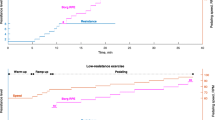Abstract
Autonomic activation as reflected by heart rate, skin conductance, muscle tension, and T-wave amplitude of the electrocardiogram were registered during biofeedback training of EEG alpha. The group of 25 subjects showed significant enhancement of alpha but no systematic change in autonomic activation. This result was interpreted as supporting Eysenck's theory of two feedback loops for mediating cortical arousal. According to this theory, autonomic changes would not be expected to accompany changes in cortical arousal during resting conditions lacking emotional content and, therefore, not involving the visceral brain. Although some of the subjects who succeeded in increasing alpha experienced it as positive and others as strenuous, alpha change did not correlate significantly either with the dimension of extraversion, or with those of locus of control and neuroticism.
Similar content being viewed by others
References
Banquet, J. P. Spectral analysis of the EEG in meditation.Electroencephalography and Clinical Neurophysiology 1973,35 143–151.
Berggren, T. Internal vs. external control of reinforcement. Unpublished manuscript, Department of Psychology, University of Uppsala, Sweden, 1972. As cited in Berggren, T., Öhman, A., and Fredrikson, M. Locus of control and habituation of the electrodermal orienting response to nonsignal and signal stimuli.Journal of Personality and Social Psychology. 1977,35, 708–716.
Brown, B. Recognition of aspects of consciousness through association with EEG alpha activity represented by a light signal.Psychophysiology 1970,6 442–452.
Brown, B. Awareness of EEG-subjective activity relationships detected within a closed feedback system.Psychophysiology 1971,7 451–464.
Brown, B.New mind, new body, biofeedback: New directions for the mind. New York: Harper & Row, 1974.
Bujatti, M., & Riederer, P. Serotonin-nonradrenalin, dopamine metabolites in transcendental meditation technique.Journal of Neural Transmission 1976,39 257–267.
Christie, M. J. The psychosocial environment and precursors of disease. In P. Venables & M. Christie (Eds.),Research in psychophysiology. London: Wiley, 1975.
DeGood, D. E., & Chrisholm, R. C. Multiple response comparison of parietal EEG and frontalis EMG biofeedback.Psychophysiology 1977,14 258–265.
Elson, G. D., Hauri, P., & Cunis, D. Physiological changes in yoga meditation.Psychophysiology 1977,14 52–57.
Eysenck, H. J.The biological basis of personality. Springfield: Charles C Thomas, 1967.
Eysenck, H. J., & Eysenck, S. B. G.Manual of the Eysenck Personality Inventory. London: University of London Press, 1964.
Frost, R. O., Burish, T. G., & Holmes, D. S. Stress and the EEG alpha.Psychophysiology 1975,15 394–397.
Goesling, W. J., May, C., Lavond, D., Barnes, T., & Carriera, C. Relationship between internal and external locus of control and the operant conditioning of alpha through biofeedback training.Perceptual and Motor Skills 1974,39 1339–1343.
Goleman, D. J., & Schwartz, G. E. Meditation as an intervention in stress reactivity.Journal of Consulting and Clinical Psychology 1976,44 456–466.
Horne, J. A. and Östberg, O. A self-assessment questionnaire to determine morningness-eveningness in human circadian rhythms.International Journal of Chronobiology. 1976,4 97–110.
Jasper, H. H. The ten-twenty electrode system of the International Federation. Electroencephalography and Clinical Neurophysiology. 1958,10 371–375.
Kamiya, J. Operant control of the EEG alpha rhythm and some of its reported effects on consciousness. In C. T. Tart (Ed.),Altered states of consciousness. New York: Wiley, 1969.
Knox, S. The alpha amplitude criterion in binary biofeedback: Its relation to reinforcement and anxiety.Report from the Department of Psychology University of Stockholm, 1978,531 1–10.
Knox, S. Effect of passive concentration as instructional set for training enhancement of EEG alpha.Perceptual and Motor Skills 1980,51 767–775.
Legewie, H. Subjektive korrelate der alpha-aktivität im EEG: Unterschiedungslernen odor Aberglaube?Zeitschrift fur Experimentelle und Angewandte Psychologie 1977,24 443–454.
Lehrer, P. M. Psychophysiological effects of progressive relaxation in anxiety neurotic patients and of progressive relaxation and lupha feedback in non-patients.Journal of Consulting and Clinical Psychology 1978,46 389–404.
Luthe, W.Autogenic therapy. Volume IV: Research and theory. New York: Grune & Stratton, 1970.
Lynch, J. J., & Paskewitz, D. Z. On the mechanisms of the feedback control of human brain wave activity.Journal of Nervous and Mental Disease 1971,153 205–217.
Morgan, C. T.Physiological psychology. New York, McGraw-Hill, 1965.
Nowalis, D. P., & Kamiya, J. The control of electroencephalographic auditory feedback and the associated mental activity.Psychophysiology 1970,6 476–484.
Orne, M. T., & Paskewitz, D. A. Aversive situational effects on alpha feedback training.Science 1973,183 458–460.
Plotkin, W. B. The alpha experience revisited: Biofeedback in the transformation of psychological state.Psychological Bulletin 1979,86 1132–1148.
Plotkin, W. B., Mazer, C., & Loewy, D. Alpha enhancement and the likelihood of an alpha experience.Psychophysiology 1976, 105, 466–471.
Polzien, P. Versuche zur Normalisierung der ST-Strecke und Z-Zacke im EKG von der Psyche her.Zeitschrift fur Kreislauf-Forschung 1953,42 9–10. Cited in Luthe, M. D. (Ed.),Autogenic therapy. Volume IV. Research and theory. New York: Grune & Stratton, Inc., 1970, p. 60.
Rotter, J. B. Generalized expectancies for internal versus external control of reinforcement.Psychological Monographs, 1966,80 (1, Whole No. 609).
Tyson, P. D., & Audette, R. A multivariate approach to the relationship between alpha waves and experience during feedback.Biofeedback and Self-Regulation 1979,4 63–79.
Wallace, R. K., and Benson, H. The physiology of meditation.Scientific American 1972, 226, 84–90.
Author information
Authors and Affiliations
Additional information
This study was funded by the University of Stockholm, Sweden. I would like to express my appreciation to Carl-Otto Jonsson and Birgitta Berglund for their helpful suggestions during the preparation of the manuscript.
Rights and permissions
About this article
Cite this article
Knox, S.S. Alpha enhancement, autonomic activation, and extraversion. Biofeedback and Self-Regulation 7, 421–433 (1982). https://doi.org/10.1007/BF00998882
Issue Date:
DOI: https://doi.org/10.1007/BF00998882



